 |
||
|
||
| ||
Processors
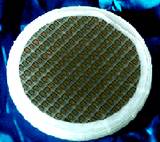 The beginning of the year brought enough messages about new processors. Intel was the first to announce itself before the end of holidays and presented the first processor already on the January 4 this year. It was the 0.13-micron 1.3 GHz Celeron. As well as its predecessors with Tualatin core, the new processor has 256 KBytes of L2 cache. After this month has passed it is pleasant to say that the processor announcement was not only on paper - in a couple of weeks it appeared for sale everywhere and even had time to became cheaper before the end of the month.
 In three days Intel has officially announced the beginning of sales of 2.2 GHz Socket 478 Pentium 4 processors with Northwood core, having 512 KBytes of L2 cache and 0.13-micron technical process. It was rather expected and predicted event as samples of this model have appeared in the Japanese retail just before the New Year. For novelty's test results see Intel Pentium 4 "Northwood": comparison with the predecessor and prospects estimation.
 Alongside the deliveries of 2.0 GHz "A" Pentium 4 have begun - the same, but with lower clock rate ("A" means 0.13-micron technical process, not to confuse it with 0.18-micron version with Willamette core). Moreover, Intel has published information on its site about the release of A models with 1.6 GHz and 1.8 GHz clock rates in both box, and OEM variants. The sense of such model release becomes clear if you look at typical dissipated power norms of 1.6-1.8 GHz models, it ranges between 30.0-49.6 W, that may, certainly, interest manufacturers of economic desktop PCs. However, meanwhile such processors were noticed in Japan only. Unlike 2.0A and 2.2 GHz Pentium 4 "Northwood" models that have massively appeared for sale before the end of January. Servers were not forgotten as well: in this field Intel has released Pentium III-S with 1.4 GHz clock rate, 512 KBytes of L2 cache, and 1.45 V core supply voltage, produced according to 0.13-micron technical process with internal copper connections - exactly as the 2.2 GHz version of Pentium 4. In the middle of January the first consignments with this processor have appeared in Japanese shops.
 For higher perfomance server systems there were only samples of 0.13-micron Socket 603 Xeon MP processors of the next generation with Prestonia core presented in January. New Prestonia processors differ from the previous Foster core generation not only by more precise manufacture and doubled L2 cache: new processors support Hyper-Threading technology for simultaneous execution of several computing processors on one processor.
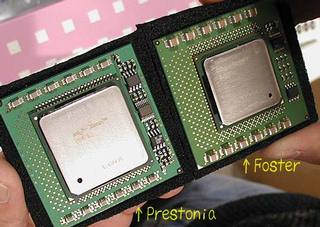 As against 1.8, 2.0, and 2.2 GHz versions of workstation Xeon with Prestonia core that is already used in systems, the official announcement and mass deliveries of its server version - Xeon MP with 512 KBytes, 1 MBytes, and 2 MBytes of L3 cache; 1.4 GHz, 1.5 GHz, and 1.6 GHz clock rates - is expected only by the end of the quarter. "Server" Prestonia will work with Intel's Plumas DDR chipsets and DDR chipset from ServerWorks; workstation variant is supposed to be used with i860 RDRAM chipset. January brought mobile processors announcements as well. Intel announced seven new models at once: 866 MHz and 850 MHz of Mobile Pentium III-M - LV versions, 750 MHz Mobile Pentium III-M - ULV version, 1.2 GHz, 1.13 GHz and 1.06 GHz Mobile Celeron chips, and 650 MHz Mobile Celeron - ULV version. All of them are made according to 0.13-micron technical process. The present position of the company is firm and cloudless as never. Manufacture lines for 0.13-micron processors are launched one by one, 0.18-micron models are removed from manufacture one by one, and the actual mass presence of new processors in shops is the obvious fact. However January novelties are nothing compared to what Intel is going to present in the nearest half-year. I mean the mass appearance of up to 3 GHz Pentium 4 processors, the nearest appearance of FSB 553 MHz models. In the field of high perfomance server and workstation processors Prestonia and Gallatin core chips are followed by "heavy" artillery - the new generation of 64-bit platform on McKinley processors and Pluto chipset.
 Already in March we'll see Mobile Pentium 4-M processors with Northwood core for mPGA479M socket - usual mPGA478B with an additional hole for a one more pin for Mobile Pentium 4-M. The new Xscale to replace StrongARM processor has already interested many manufacturers of mobile devices, being supported by the close cooperation of Intel and Microsoft. We'll find out all details about company's new technological developments from materials about Intel Developer Forum that will take place right at the end of February. However the pledge of Intel's future successes is the trouble-free work in present. Now four 200 mm and one 300 mm company factories already release 0.13-micron processors. One more big 0.13 micron 300 mm factory will be launched this year. Deliveries of 0.13-micron processors are to surpass the deliveries of 0.18-micron processors already in the middle of this year. Seems that the company will at last be able to provide uninterrupted processor deliveries in the first quarter, having increased their production by 50% in comparison with the last quarter of 2001. AMD entered the New Year with the release of the next desktop PC processor, marked "2000+" according to QuantiSpeed. The real clock rate is 1.66 GHz, the rest has nothing new: FSB 133 MHz, L1 cache - 128 KBytes, L2 cache - 256 KBytes, AMD 3DNow! Professional and the old 0.18-micron technical process.
 1.3 GHz AMD Duron processor, also differing by nothing from its predecessors except for increased by 100 MHz clock rate, was released for the consumer PCs in January: the same FSB 200 MHz, the same 0.18-micron technical process on Fab 25 in Texas, USA.
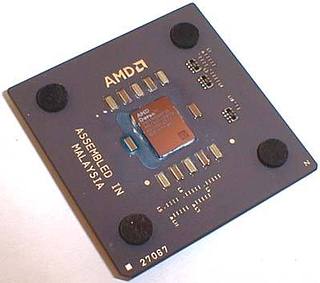 Mobile PC manufacturers got new Mobile AMD Athlon 4 1500+ in January. This time AMD has gone against QuantiSpeed doctrine: 1500+ for some reason marks the chip with FSB 200 MHz and 1.3 GHz real clock rate though, analogically to desktop PC Athlon XP processors, 1500+ model should have 1.33 GHz clock rate. Will Mobile AMD Athlon 4 and Athlon XP differ in the future ratings? Two new Mobile Durons with 1.2 GHz and 1.1 GHz clock rates were the last of AMD's January announcements. All three mobile novelties support PowerNow! And 3DNow! technologies, they are made according to 0.18-micron technical process on Fab 30 in Dresden, Germany. It is not necessary to be an analyst to the notice technological lag of the company: AMD's situation is like Intel's in the last fall - very hurriedly preparing manufacture lines for 0.13-micron chips. These plans of AMD are grandiose: having launched the mass production of 0.13-micron processors with Thoroughbred core in the first quarter, the company is going to transit all Athlon processors to 0.13-micron norms already before the year-end. Whether it will succeed is a big question. Besides, the release of the first Athlon XP 2200+ with Thoroughbred core planned only to the end of the quarter will give significant time odds to Intel along with an opportunity to win the part of the market that AMD got last year as a result of intense 0.18-micron chips parity. I think the intermediate release of "usual" 0.18-micron Athlon XP 2200+ with Palomino core will not change situation much, and AMD will only have its price weapon against the competitor. However, in the consumer PC market it will be harder to stand against new 0.13-micron Celerons with 256 KBytes of L2 cache, and analysts prophesy AMD serious losses in this sector. Only in the second quarter, when the mass production of 0.13-micron Athlon XP 2500+ Thoroughbred with 80 sq. mm crystal size is launched, and when modern Duron with Appaloosa core and mobile Athlon 4 Thoroughbred appear, the company will probably return the position and will be able to expect the regain of profitableness. The new form-factors for next generation mobile processors presented at Platform Conference were the most interesting technological innovations of AMD.
 In particular, they showed Low Profile Socket 462 that, unlike standard Socket A for desktop PC processors with 5.5 mm height, will have only 4.2 mm height and will be equipped with absolutely other fastening mechanism than ZIF. As alternative miniaturization AMD is going to offer MicroPGA Socket 563 only 33x33 mm in size. The height of socket with installed 0.13-micron Athlon 4 with Thoroughbred core will not exceed 4.74 mm.
 It's still far to the mass appearance of AMD's 64-bit Hammer processors, however, the preparations for this event can be seen already now. So, in January Wasabi Systems announced the end of preliminary porting of operating system NetBSD to x86-64 platform. But still the testing is performed with VirtuHammer x86-64 emulator from Virtutech, as there are even no rumors about working samples of Hammer processors. But it has become known that right at the end of 2001 AMD registered five new trade marks in the United States Patent and Trademark Office (USPTO): AMD FORTON, AMD METARON, AMD MULTEON, AMD VANTON, and AMD OPTERON - obviously for Hammer family processors. In January Motorola announced the long-awaited updated versions of G4 7450 and G4 7440 processors - accordingly, PowerPC MPC7455 and MPC7445. 1 GHz MPC7455 processor is interesting because it is made with application of SOI technology, but actually according to the old 0.18-micron technical process. SOI is also used in MPC7445; however, it has not yet overcome 1 GHz threshold.
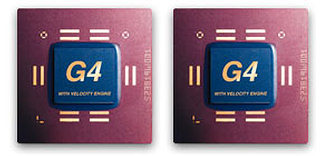 Apple was the first to react to the release of new PowerMac G4, having announced the system with two 1 GHz MPC7455 along with single processor models with 933 MHz and 800 MHz chip versions. However, Motorola could hardly update its PowerPC line basing only on purchasing capacity of Mac users. Besides Apple desktops, MPC7450 is used in routers and other high-speed equipment from brands (for example, Cisco), and MPC7440 - in Apple notebooks and not only in them. One of the pleasant January news for Motorola was the intention of Ericsson to build its new GPRS infrastructure equipment on MPC7445. Unfortunately, Transmeta has not shown almost anything again last month. Despite the beginning of Crusoe TM5800 deliveries, promised to the beginning of February and the beautiful performance at CES 2002 exhibition in the first half of January, the company has not achieved any tangible success. It has only told the story about the reconsidered development strategy. Briefly, the essence of marketing policy is that counterbalancing Intel and AMD, which intend to promote solutions with about 25-30 W dissipated power for extralight notebooks, Transmeta is going to concentrate on the release of x86 processors with less than 7 W power consumption that do not demand any heat sinks with air-cooling.
 At CES 2002 the company showed its updated processor roadmap along with the basic directions of Crusoe family development:
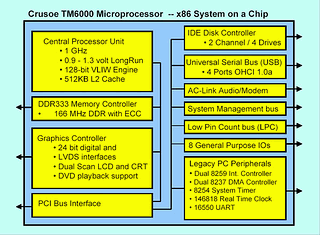 Ah, dreams... After Banias appears at the end of 2002 / the beginning of 2003, it will be difficult to predict what Transmeta will have. At such development rates that the company has been showing for the last half-year, AMD with MIPS developments of purchased Alchemy Semiconductor might rather enter this market instead. Transmeta has beautiful and iridescent plans, but still it is good to see real processors from time to time. MotherboardsJudging by events of the last month, chipset manufacturers are now concerned with just few questions: DDR333 memory support. USB 2.0 and ATA/133 interfaces integration. It's all, if not to take into account mobile or integrated variants. Inconsistency and non-observance of these modern requirements make board manufacturers offer non-standard solutions up to packaging boards with additional add-in cards. As far as it's known, USB 2.0 support will be integrated into south bridges in the second quarter: Intel is going to release ICH4, VIA prepares to release its V8235. According to the preliminary data, both chips will support up to six USB 2.0 ports. Now USB 2.0 is supported, for example, by AMD-760MPX, dual-processor ASUS A7M266-D board, only due to an additional NEC's PCI USB 2.0 card.
 However, in case of Socket A platforms the most important question is still the presence of instant hardware protection from processor overheating. Only two manufacturers directly announced the support of thermodiode for protection from instant overheating of AMD Athlon XP/MP processors - Fujitsu Siemens with the updated D1289 KT266A board (Thermal Management technology, see the photo below) and ASUS with A7V333 board based on the new KT333 chipset (ASUS C.O.P - CPU Overheating Protection technology). I think other manufacturers would have intensely promoted such protection if they had it. However, there is nothing about protection from instant overheating as you peer into lines of fresh press releases. Frankly speaking, I'm upset with such inattention to this rather serious problem.

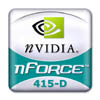 Having debuted in the chipset sector at the end of 2001 with integrated nForce 420D, 220D, and 220, NVIDIA decided to strengthen the position in this market, and announced the release of nForce 415 in January that differs from its "senior" nForce 420D colleague by a new "pared-down" IGP 415 north bridge. Unlike IGP 420 (see our NVIDIA nForce chipset article), IGP 415 has no graphics core and is packaged with former MCP/MCP-D south bridges. NVIDIA's benefit is obvious: the price of such chipset is $20-25 less than that of the integrated variant. Accordingly, we might expect better sales of such boards. Already in January nForce 415 releases were announced by ASUS (A7N266-C, see photo below), Leadtek (K7N415), and MSI (K7N415); and Fujitsu-Siemens, MicronPC, Alienware, and others are going to deploy the manufacture of complete systems.
 January mess with KT333 chipset release was a little confusing. According to preliminary data, the chipset should have been presented on January, 17, and... That's all.
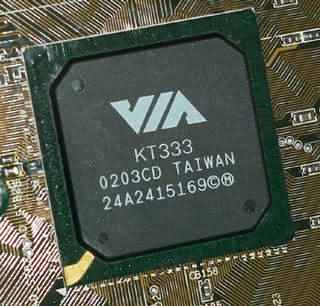 Seems that after this "false start" some companies have nevertheless inertially presented their solutions - officially, but on the unannounced chipset. Among them are: A7V333 board from ASUS, already mentioned above, AK37 and AK37GTR (with HP372 ATA/133 IDE RAID controller) from Shuttle, SL75DRV5 (+ VT8233A) from Soltek, KT3 Ultra (ATA/133 IDE RAID controller from Promise) from MSI, and others. The partial answer to such situation was given by appeared, but still unconfirmed rumors, that VIA is going to announce an advanced variant of this chipset - KT333A - on the VIA DDR333 Summit, planned after the Chinese New year. Besides DDR333 memory support, it will have updated V-Link bus with up to 533 MBytes/sec bandwidth. New chipsets were also announced in January: VIA has presented VIA ProSavageDDR KM266 - the updated integrated version of VIA ProSavage KM133 for AMD processors, with DDR SDRAM memory support, integrated 2D/3D AGP 4x S3 Graphics ProSavage8 graphic core, and in case of VT8233A south bridge usage - with Ultra ATA/133 support.
 Mobile Pentium III-M, Pentium III, CeleronT, and VIA C3T were not forgotten as well: DDR266 version - VIA ProSavageDDR PN266T or Twister-T DDR - was released for them. It supports FSB 133 MHz, Intel SpeedStepT technology, has ProSavage8T integrated graphic core from S3 Graphics, and integrated dual-channel LVDS transmitter.
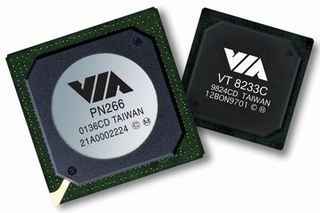 Besides new chipset releases, VIA actively promotes motherboards under the aegis of VIA Platform Solutions Division (VPSD). So, in January it announced the beginning of certified VIARAMA program for motherboards based on Apollo P4X266, Apollo P4X266A, and ProSavageDDR P4M266 chipsets. VIARAMA boards will be tested for conformity to the modern standards and sold with special stickers on retail packages and boards. In other words, it's a normal brand.
 In January SiS began to deliver the first samples of SiS646, renamed to SiS645DS afterwards, and SiS651 chipsets to its clients - new SiS645 and SiS650 versions, accordingly. The new chipsets' distinctive feature is FSB 533 MHz support and ATA/133 interface; besides SiS651 will quite probably have a remade graphic core. The mass production of SiS646 and SiS651 is planned for March. Further plans of SiS concerning Pentium 4 platform can take one's breath away: in March the company is going to present SiS648 chipset, supporting FSB 533 MHz, DDR400 memory, and AGP 8x bus. SiS648, being pin compatible with integrated SiS660, will also be equipped with the new SiS962 south bridge with USB 2.0 and IEEE 1394 support. In January Intel released only a new stepping of i845 SDRAM chipset, being a pared-down version of i845D stepping B0 with hardware disabled DDR-controller. The sense of i845B0 SDRAM release is that it's much cheaper than the old i845 SDRAM. Memory productsDRAM prices continued to raise moderately since the beginning of the year. In January Hynix and Samsung announced long-term increases of DRAM contract prices twice: by 30% in the beginning, then - by 20-30%. By the end of the month the price of 128 MBit DDR SDRAM chip has reached $4, and the price of 128 MBit SDRAM chip - $3.20-3.50. According to analysts, prices of 128 Mbit SDRAM chip on the level of $3.5 per unit mean restoration of such manufacture profitability. Some marketing companies are already seriously speaking about raising this mark up to $5 closer to spring. However, prices stabilized a little closer to February: probably, despite "wishes" of manufacturers, the offer has at last satisfied the demand, at least, for prices offered. January rounds of negotiations about Micron purchase of Hynix's capacities finally came to an impasse at the end of the month: Micron offered $3.1 billion, Hynix wished to get $5 billion. Meanwhile, Hynix without any pause launched pilot 0.14-micron manufacture line for 256 MBit chips on the factory in Oregon, USA, closed for the re-equipment last year; and also in parallel started cooperation negotiations with Infineon, not refusing from further negotiations with Micron. So, it's about who offers more. Or whose offer is more interesting. One thing is clear: sooner or later company creditors will nevertheless accept one of offers, as Hynix's $6 billion debt has to be restructured somehow. The entire January was about the announcement of new DDR333 memory chips and PC2700 memory modules. In the beginning of the month Transcend announced the deliveries of 128, 256, and 512 MBytes modules (on the photo: 52 MBytes PC2700 module).
 Kingston followed with the message about trial sales of 128 MBytes and 256 MBytes PC2700 modules. Samsung was the best as always, having announced on the Platform Conference about launching the pilot DDR333 and DDR400 memory chips manufacture, accordingly, for PC2700 and new DDR-II memory modules. At the end of the month the company launched the mass production of 128, 256 and 512 MBit DDR333 chips. To not lose the initiative in this field, VIA, together with Advanced Validation Labs (AVL), announced the beginning of the program for standardization of conformity of DDR333 memory modules to JEDEC norms. The reference platform for this testing was developed by VIA itself, the software was ordered from AVL. VIA certification is interesting because, like Kingston's, it includes tests at increased temperature. However, according to some analysts, the time of wide DDR333 memory introduction has not come yet. It is difficult to judge, whether Taiwanese chipset manufacturers - ALi, VIA, and SiS - run for it too early, offering DDR333 support or Intel "brakes" everything, having only recently released DDR266 chipset. However until Intel is aimed at DDR200/DDR266 support, there will be little sense in PC2700 introduction, and wide adoption won't take place. Besides, memory manufacturers often argue about packing new high-speed chips while at JEDEC they are still discussing packing of DDR II. Nevertheless, the more or less wide appearance of DDR333 chips in the market is a proven fact, and the appearance of motherboards with the corresponding support is a question of month or two. If Intel won't make it, competitors will "help". The last month was rich enough with announcements of new memory manufacture technologies. Micron announced the preparation for release of a completely new type of nonvolatile memory chips - MRAM - with less than 1 V supply voltage and 50-60% less power consumption in comparison with usual memory of this class. The programmable metalization cell (PMC) technology, developed by Axon Technology together with Arizona University, was used for creation of nonvolatile chip cells. Micron is going to apply the special chalcogenide mix, based on silver, for covering usual CMOS memory cells for release of the most economic MRAM chips. Toshiba released 8 MBit SRAM chips with low energy consumption especially for mobile phones. Chips are made according to 0.15-micron technical process and have 40 ns access time. In the near future the company is going to release 4 and 16 MBit SRAM chips as well. MoSys announced the development of a new technology for built-in 1T-SRAM-R memory manufacture, based on 1T-SRAM with the standard SRAM interface and TEC (Transparent Error Correction) technology. Fujitsu and Toshiba informed about the release of the specification for the second generation Fast Cycle RAM with 25 ns direct access cycle and up to 200 MHz clock rates and up to 400 MBit/sec data transfer. According to the specification, new FCRAM will be 17% faster than first generation chips; the productivity of the new memory will increase by 30%. FCRAM-II will be manufactured according to 0.175-micron technical process. In January NEC announced the superfast economic 64 MBit DRAM chip with 4 MBitx16 organization, 18 ns page access time and 65 ns cell access time. New DRAM is pin compatible with SRAM and has an integrated self-restoration module. Power consumption parameters are impressive: maximum operating current - 100 microampere, idle mode - 60 microampere, deep dream mode - 10 microampere. It's a rather perspective development as NEC already develops 128 MBit chip. And separately about Rambus. Despite the announced reduction of incomes for the last quarter by 11% down to $24.9 million, company profit dropped only a little - from $6.5 million in the third quarter down to $6.2 million in the last. According to company representatives, incomes will drop by 3-7% in this quarter due to RDRAM prices reduction. Despite Samsung's announcement about the beginning of pilot manufacture of 1066 MHz RDRAM chips for RIMM 4200 modules and the presence of 1200 MHz chip samples, despite RDRAM price, comparable with DDR SDRAM price, some analysts believe these are the last months of good RDRAM demand, taking into the account its lesser demand for PCs, Sony PS2, and communication equipment. Nevertheless, according to Samsung, 256 MBit RDRAM chips have superseded 128 MBit ones by the end of 2001. In the second half of 2002, when the mass production of 1066 MHz and 1.2 GHz 256 MBit RDRAM chips is expected, Samsung plans to transit to 0.13-micron technical process that will help to reduce RDRAM cost price.
 So, RDRAM destiny is specialized niche applications and 10-12% of the memory market for high-perfomance PCs. VideoAt NVIDIA the first month of the year passed in the atmosphere of preparation for the February announcement of the next generation GeForce 4 graphic chips - NV17/NV25. So, neither company, nor its partners showed especial activity. Among January novelties, perhaps, it's worth to mention Leadtek's release of 128 MBytes WinFast Titanium Ti200 card, and 128 MBytes G321 cards with the same GeForce3 Ti200 chip from Chaintech. Besides, at MacWorld NVIDIA together with Apple announced that its graphic accelerators are now the standard for all Macintosh desktop platforms. New Apple iMac serie, announced at MacWorld, featured graphic controllers based on GeForce2MX.
 Right at the end of the month, when single and dual processor models with MPC7455 were announced, it turned out that Apple equipped "lighter" 800 MHz model with ATI RADEON 7500, and two "senior" models - with 64 MBytes GeForce 4 MX cards a week before the official announcement of these solutions! Another interesting event: at Platform Conference NVIDIA offered an inexpensive daughter card with DVI decoder for motherboards with integrated graphics (for example, with nForce chipset) and a free AGP slot. The sense of the offer was the multiplexing of DVI and standard AGP signals via AGP bus, causing only minor changes in BIOS, and not in board wiring. Offer's co-authors were ALi, Asustek, Chaintech, Chrontel, Conexant, LG/Philips, QDI, Silicon Image, and Tatung. And 4mbo., Asus, Abit, Fujitsu/Siemens, Gigabyte, MicronPC, Mitac, and MSI have joined the initiative and will release such solutions. Chrontel, Silicon Image, and Conexant have already made samples of such daughter cards. In other words, the company was mostly occupied with preparations for a February triumph (a successful one, by the way). January was "presented" to ATi, and it has undoubtedly taken the full advantage of it. First, ATi presented the analog video decoder THEATER 200 with integrated sound processor that should become a chip partner for All-In-Wonder videocards. Besides, THEATER 200 will become a component of integrated XILLEON 220 chip for the market of digital TV boxes, announced in October on MPF 2001. THEATER 200 can capture signal to Composite, S-Video, and Component (including HDTV) inputs and convert them into ITU-656 compatible format of real time digital video. THEATER 200 can decode analog audio streams into digital and transfer them via I2S bus for further processing by the sound processor. Wishing to "squeeze" maximum out from the ATI RADEON 8500, in February the company has announced the release of AGP version of RADEON 8500 MAC EDITION card for Mac platform. It's the same as the PC version, but the chip clock rate is 250 MHz. It was followed by the announcement of ATI RADEON 7000 MAC EDITION - consumer PCI cards for old Power Mac system users, wishing to upgrade their PC, and also for owners of new Power Macs with AGP cards, interested in getting a second monitor output and having a free PCI slot.
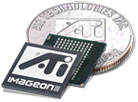 IMAGEON 100 graphic processor, announced by the company for use in PDAs and smartphones, became a serious claim for entering the mobile sector. IMAGEON 100 fully supports MPEG-4 decoding, has expanded 2D graphic engine capabilities for animation output and fast rendering, font caching and smoothing, scaling, etc. The chip is equipped with 384 KBytes of built-in SRAM for double buffering images with standard 240 x 320 PDA screen resolution, and an external SDRAM controller for up to 800 x 600 resolutions support with up to 16 bit/pixel color depth. Besides, IMAGEON 100 supports ATI POWERPLAY energy saving technology. Due to standard SRAM interface, IMAGEON 100 can be used in combination with the majority of widespread PDA processors: Intel StrongARM, and XScale, Motorola DragonBall, NEC MIPS, or Hitachi SH. The chip includes programmable LCD Timing Controller (TCON), compatible with a wide list of LCD panels from different manufacturers: from 1-bit monochrome up to 18-bit color STN or TFT panels. Other January news from ATI were more prosaic, applied and, hence, more actual for the end user. In the last month the deliveries of the average level professional ATI FIRE GL 8800 card have started at last.
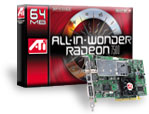 ATI has announced not only the sales of universal ALL-IN-WONDER RADEON 8500 DV card, but also the release of ALL-IN-WONDER version with RADEON 7500 chip with 32 MBytes DDR SDRAM, stereo 125-channel TV-tuner, TV-broadcast record capability (ATI TV-On-Demand), radio remote control, HydraVision support, etc. In other words, a simplified version of AIW 8500 DV for just $199. In January ATI "supporters camp" was updated with two authoritative videocard manufacturers -European Hercules and Taiwanese Gigabyte. ATI is going to fully cooperate with Hercules: the latter has received the exclusive right for European deliveries of ATI ALL-IN-WONDER universal cards through retail and distribution channels. Besides, Hercules has received rights for the release and distribution of RADEON 8500-based cards. The first of them was the 3D Prophet FDX 8500LE based on ATi RADEON 8500LE chip with 250 MHz clock rate and 64 MBytes DDR memory working at 250 MHz. Due to this contract, there's an opportunity to see Hercules 3D Prophet ALL-IN-WONDER 7500 in February in the European market. Hercules 3D Prophet All-In-Wonder 8500DV card, supporting European TV standards (PAL B/G/D/K/I, SECAM L/D/K), will appear for sale little later.
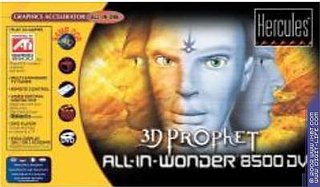 Gigabyte's message about reorientation of manufacture to ATi chips along with ATI's share price increase was rather unexpected. At that Gigabyte is going to increase videocard manufacture volume from 1.2 million units in 2001 up to 2.5 million in 2002. According to company representatives, ATI's discounts and "competitive ability" of its products seemed attractive.
 At once in January, Gigabyte presented three cards based on ATI chips: AR64S-H ATi Radeon 7500 Pro based on 250 MHz RADEON 7500LE, AV64S-T ATi Radeon7000 Pro based on RADEON 7000, and AG32S ATi RAGE 128 Pro based on ATi RAGE 128. The next step is the release of top-model line based on Radeon 8500, but it's another - February - story... In January PowerColor was noted with products based on ATI chips, having released EVIL KNIGHT RADEON 7500LE based on standard Radeon 7500LE. FIC was noted as well, having released a complete line based on Radeon 8500LE, Radeon 7500, Radeon 7200, and Radeon 7000 chips. Joytech released two little unusual cards for exotic fans - ARV200A1NLD-128M based on RADEON 7500 and Apollo 8500 based on 8500LE, equipped with 128 MBytes of memory.
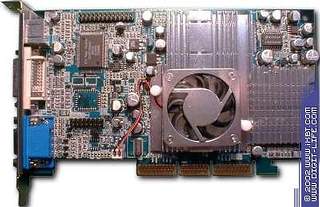 And sad news in closing. Matrox, that in due time was considered the standard in the field of manufacture of inexpensive cards for video processing, decided to leave this market. The release of new drivers for Matrox Marvel e450 is cancelled; the latest drivers are announced as final in all senses. Accordingly, e450 became the latest of this serie. Matrox representatives said that the development
and release of semi-professional and professional cards for video
processing will be continued. However it's far from consumer market.
Seems that the good name of Matrox is still farther from the usual
retail. And frankly speaking it's sad that we part with this company.
Write a comment below. No registration needed!
|
Platform · Video · Multimedia · Mobile · Other || About us & Privacy policy · Twitter · Facebook Copyright © Byrds Research & Publishing, Ltd., 1997–2011. All rights reserved. |